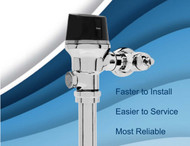Delany Product Focus: The Pulsar Valve | Delany Equipment Repair & Replacement Parts
Mar 27th 2024
In the wake of the COVID-19 pandemic, these days, commercial restroom trends are driven by touchless technology in the hope of containing the spread of any virus. The Delany Pulsar Valve and Delany equipment repair and replacement parts are some of the commercial flush valves at the forefront of this change.
This article talks about Delany’s The Pulsar, a sensor-operated flush valve that addresses customers’ demand for cleanliness and minimal surface contact in public commercial restrooms.
The Delany Pulsar
The Pulsar is faster to install, easier to service, and is one of the most reliable sensor-operated commercial flush valves in the market.
Pulsar's minimal number of internal parts and pre-packaged assembly are what make this valve different from other flush valves.
With only a few internal parts, there's less chance of it breaking down and when it does, you only have to repair or replace a minimal number of parts, saving you time and money in the long run. With fewer parts, this also means it will be easier to service and maintain.
Also, because it's already assembled, you can install it about 50% faster than other flush valves with several parts to put together.
The Pulsar also has a state-of-the-art solenoid. Solenoids control the flow of water from the valve's inlet to its outlet. It is an essential component of the flush valve and typically the part that often needs repair and maintenance. The Pulsar’s high-quality solenoid makes this valve highly suitable for environments with high restroom usage.
The Pulsar has also been tested to last over 400,000 operations on a single battery. Simply put, you can rely on The Pulsar to get you through even the busiest days of your restroom and for a longer time. It's one of the most reliable sensor valves on the market!
Parts Breakdown
The Pulsar flush valve comes completely assembled. Following are the breakdown of its parts:
- lithium battery with 10 years of shelf-life
- USA manufactured electronics
- USA manufactured solenoid tested up to 2 million operations
- low battery indicator light
- electronic override pushbutton
- range adjustment potentiometer
- flush time adjustability switch
- renewable main valve seat
- blank handle nut cap
- optional 24-hour flush
- one universal diaphragm for water closets and urinals
Troubleshooting Guide
Worn flush valves cause toilet problems, especially in a high-traffic restroom. Review the common problems and the solutions below to avoid downtime in your restrooms. For emergency situations, it's best to stock on Delany equipment repair kits.
Valve won’t flush
When a valve won't flush, it's usually because it's not getting enough power, the range is too short or too long, the Control Stop is closed, or some parts on the circuit board are damaged.
- Replace the battery with a fresh one.
- Adjust the "white" range dial by loosening the set screws on the head. Turn it clockwise to about a 10 o'clock setting.
- Shorten range by rotating the "white" range dial counterclockwise within the valve head.
- Open the Control Stop using a screwdriver.
- Remove the valve head and replace it with a new one.
Valve starts flushing but closes immediately
When the diaphragm is shutting down too quickly, it could be because the diaphragm is ruptured or the diaphragm is oversized and a secondary bypass has occurred.
- Use the appropriate Drop-in Kit to replace the diaphragm.
- Make sure all pieces, such as the seat guide, are secure. If all the parts are screwed tight, you may need to change the bypass.
Flush volume is not enough
When there is a short flush, it means the water refill isn’t enough.
- Loosen the set-screws on the valve head to remove it. Lift the head gently and turn it over. Use the screwdriver provided to turn the red-colored dial discharge switch. Proceed to the next highest setting. Each setting uses 10% more water than the previous one.
Flush volume is too much
When the flush volume is too much, it could be because the water pressure is too high, the water discharged by the diaphragm is greater than the toilet, the diaphragm's bypass is blocked or partially blocked, or the solenoid is blocked or partly blocked.
- Make sure the building's water pressure is less than 80 pounds per square inch (PSI). To control water pressure, a Pressure Reducing Valve (PRV) can be installed.
- Reduce discharge by lowering the Discharge Switch setting.
- If the previous steps do not resolve the problem, install a new diaphragm that matches the currently installed diaphragm's gallons per flush (GPF).
- Blow into the bypass to ensure that it is clear and open. Otherwise, a new diaphragm should be used.
- Replace the solenoid with a new one.
You can buy a Pulsar assembly and Delany equipment repair and replacement parts here at Quality Plumbing Supply. Browse through our inventory and contact us if you need assistance choosing the right part for your new installation and repair projects.

